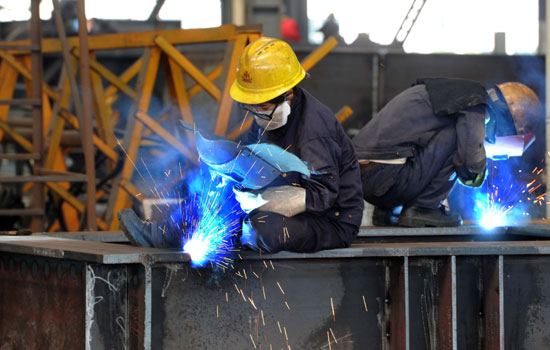Signs suggest stable Q3 growth
17 january 2013
 |
|
An oil drilling equipment manufacturing plant in Guanghan, Sichuan province. China’s economic growth has started to stabilize and positive signs have been seen during the third quarter, said Premier Wen Jiabao, adding that the country still faces considerable difficulties in the final quarter. [Photo/China Daily] |
China’s economy in the third quarter showed signs of taking a turn for the better, a development expected to support growth, Premier Wen Jiabao said.
Many analysts saw the premier’s statement as suggesting that the country’s economic slowdown bottomed out in the past three months.
“China’s economy will continue to stabilize as government policies get further implemented,” said Wen, according to a report from the central government website on Wednesday.
The premier made the remarks at meetings he held from Friday to Monday with economists, business executives and local government officials.
The National Bureau of Statistics is set to release economic data about the country’s third quarter on Thursday.
“We didn’t adopt a large stimulus package to promote growth, and many enterprises have been pushed to adjust their business structures to fight against the current risks,” Wen said.
Last Thursday, top Chinese economists called for the country to lay the foundation for its own stable growth by moving more quickly to make market reforms and embracing a “new period of openness”.
China can only maintain a high rate of economic growth in the next decade by allowing industries that are able to compete internationally to develop in a relatively unimpeded way, scholars said at a forum at Tsinghua University.
The 18th National Congress of the Communist Party of China, the occasion for a change in the country’s top leadership, is scheduled to take place in three weeks. Policy advisers said the government’s chief task in the coming years will be to change the country’s fundamental way of achieving economic growth.
Free competition should be encouraged among highly profitable industries, such as telecommunications and transportation, said Justin Yifu Lin, former chief economist of the World Bank.
China’s economic development in the past 32 years, resulting in an average annual growth rate of 9.9 percent, has been “a miracle”, Lin said.
“Per capita income reached $5,400 in 2011, meaning it is already a middle-income country.”
If China doesn’t come to rely on a new source of economic growth, it may face difficulties similar to those found in Latin American countries, he said.
Amid the sluggish global economy, China’s growth has slowed in six quarters in a row, decreasing to 7.6 percent in the second quarter this year.
At least one other economic indicator, though, rebounded slightly in September. China’s official factory Purchasing Manager’ Index increased to 49.8 from 49.2 in August, the first increase in five months.
A score above 50 on the index indicates expansion.
In addition, the rate of increase in exports bounced back to 9.9 percent from 2.7 percent in August, suggesting that market demand had become stronger.
“The pattern of economic growth has become obvious by now, as is proved by the narrowed trade surplus and the fast increase in residents’ consumption,” said Li Daokui, a former adviser to the central bank, who is also a professor at Tsinghua University.
“However, the Chinese economy may pass through a difficult period during the next three to five years, along with the restructuring, which started at the beginning of the 12th Five-year Plan (2011-15),” Li said.
The proposed market reforms are expected to boost high-tech and emerging industry growth and strengthen businesses’ ability to compete internationally, economists said.
“One of the priorities is to develop medium-sized and small financial institutions to channel more capital into the private sector,” Lin said.

Recent Comments